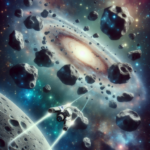Should you be afraid a spaceship might crash in the asteroid belt like in the movies? Quick verdict
Quick verdict: No — you dont need to be afraid that a spaceship will crash in the asteroid belt like in the movies. Hollywood dramatizes dense fields of rocks for tension, but the real main asteroid belt between Mars and Jupiter is extremely sparse and spacecraft routinely pass through without incident.
The apparent danger comes from a misunderstanding of density and scale: most asteroids are widely separated by hundreds of thousands of kilometers, and the large, movie-style collisions are exceedingly rare. Spacecraft have successfully navigated this region on their way to the outer solar system, demonstrating that a collision with a sizable body is not a realistic everyday threat.
There are real, smaller risks—micrometeoroids and dust can strike a spacecraft at high speed and cause damage—but engineers design missions to manage those hazards. Mission teams use careful trajectory planning, cataloged asteroid data, onboard navigation and imaging to avoid known objects, and physical protections like shielding and redundant systems to mitigate impact effects.
Space agencies and astronomers continuously monitor and model the small-body population, and mission planning factors that information into every interplanetary launch, so the public-facing risk of a dramatic belt collision remains negligible.
What is the asteroid belt really like: density, distances, and common misconceptions
The asteroid belt lies between Mars and Jupiter at roughly 2.1–3.3 astronomical units (AU) from the Sun and contains millions of rocky bodies ranging from dust-sized grains to dwarf planets. Despite its population, the total mass of the main belt is small — only a few percent of the Moon’s mass — and most of that mass is concentrated in a handful of large objects rather than spread evenly among countless boulders.
When people talk about the belt’s density, they often mean how closely packed the objects are in space. In reality the belt is mostly empty: average separations between the larger asteroids are on the order of hundreds of thousands to millions of kilometers, and collisions between large objects are relatively rare. Spacecraft routinely cross the main belt (for example, NASA’s Dawn mission at Vesta and Ceres) without encountering solid obstacles, which underscores how sparse the region is compared with popular portrayals.
Size distribution matters: the belt contains a few large bodies and a vast number of much smaller fragments and dust produced by past collisions. This means local density can vary — dust bands and families of fragments exist where collisions have occurred — but the overall environment is still dominated by empty space. The main belt is also dynamically shaped by Jupiter’s gravity and by resonances that clear or concentrate material, so spatial structure is non-uniform rather than a continuous ring.
Common misconceptions include the ideas that the belt is a thick, dangerous traffic jam of rocks or that it represents a single “failed planet.” In truth, the belt is a dispersed population of leftover planetesimals whose current arrangement reflects billions of years of collisions and gravitational sculpting. While meteorites found on Earth often originate from the main belt, hitting a spacecraft or navigating through a dense field of asteroids is far less likely than movies suggest.
How likely is a spacecraft collision in the asteroid belt? Scientific risk assessment and real-world statistics
Collision risk in the asteroid belt is extremely low—the belt is not a densely packed minefield but a region of very sparsely distributed bodies. Most of the belt’s mass is concentrated in a few large asteroids, and the average distances between kilometer-scale objects are vast compared with spacecraft sizes. Because of that low spatial density and the short time a spacecraft typically spends crossing the belt, mission planners and astronomers assess the probability of an impact with a large asteroid as negligible for routine transit trajectories.
Scientific risk assessment combines observations, statistical models and mission engineering. Astronomers use surveys to estimate the size–frequency distribution and spatial density of asteroids, then simulate encounter probabilities given a spacecraft’s planned trajectory and crossing time. Engineers factor in relative velocities, cross-sectional area, and the known population of small bodies; they also evaluate the greater hazard posed by untracked micrometeoroids and dust particles, which are far more numerous than large bodies and represent the dominant small-impact risk.
Real-world statistics support the low-risk conclusion: many spacecraft have traversed or operated within the asteroid belt without recorded collisions with major asteroids, and there are no documented catastrophic losses attributable to hitting a belt asteroid. While micrometeoroid strikes and single-particle impacts are recorded occasionally on spacecraft hardware throughout the solar system, those events are typically isolated, low-frequency occurrences that mission teams anticipate and mitigate through design margins and operational monitoring.
Key factors considered when estimating and managing collision risk include:
- Spatial density and size distribution of objects along the trajectory
- Relative velocity between spacecraft and potential impactors
- Cruise time through the belt—longer exposures slightly increase cumulative probability
- Mission-specific mitigations such as pre-flight surveys, trajectory selection, shielding, and contingency maneuvers
Why movies make the asteroid belt seem deadly: cinematic exaggeration vs. mission data
Movies make the asteroid belt look like a lethal minefield because dense clouds of tumbling rocks and nonstop collisions create instant, cinematic peril. In reality, the main asteroid belt is mostly empty space. While Hollywood shows spacecraft weaving through narrowly spaced boulders, telescopic surveys and spacecraft observations reveal that sizable asteroids are separated by vast distances and occupy well-defined orbits, so the chance of an unplanned, catastrophic impact during a transit is extremely low.
Mission data supports a much calmer picture. NASA and other space agencies have safely sent probes through or past the main belt and to individual asteroids: Pioneer 10 and 11 traversed the belt on their way to the outer planets, Galileo made close flybys of Gaspra and Ida, Dawn orbited Vesta and Ceres, NEAR Shoemaker orbited and landed on Eros, and sample-return missions such as Hayabusa, Hayabusa2 and OSIRIS‑REx have studied near‑Earth asteroids up close. These missions showed that spacecraft routinely navigate the environment without encountering the torrents of rubble that movies imply.
Why filmmakers exaggerate
- Visual drama: Fast-moving debris and collisions show immediate danger on screen.
- Narrative clarity: A visible obstacle is easier for audiences to understand than invisible orbital gaps.
- Scale compression: Realistic distances and timescales don’t translate well to a two-hour story.
From an engineering standpoint, mission planners use precise orbital mechanics, target tracking and risk assessments to route spacecraft through predictable corridors and avoid known objects. Large fragments are cataloged and tracked, and spacecraft are designed to withstand micrometeoroid impacts within expected limits. Combined, observational surveys and decades of mission experience paint a picture of the asteroid belt as a region of sparse targets and manageable operational risk—very different from the constant, crushing hazard portrayed in most films.
How space agencies avoid collisions: tracking, navigation, shielding, and mission planning
Space situational awareness begins with continuous, high-precision tracking of objects in orbit. Ground-based radars, optical telescopes and space-based sensors collect observations that feed into catalogs of space debris and operational satellites. These data are processed to produce updated ephemerides and perform conjunction assessments—predictions of close approaches—which form the backbone of any effective collision avoidance program.
Precise navigation and orbit determination are essential to turn tracking data into action. Spacecraft use a combination of ground-derived ephemerides, onboard sensors (star trackers, GNSS receivers) and relative-motion models to refine their trajectories. When a hazardous conjunction is identified, teams compute and execute timed propulsive maneuvers—often small delta-v burns—to alter an orbit sufficiently to reduce collision probability without compromising mission objectives.
Design measures like protective shielding and redundancy reduce vulnerability to unavoidable impacts by small debris. Multi-layer Whipple-style shields, strategic placement of critical avionics, and fault-tolerant systems limit damage from micrometeoroids and fragments too small to reliably track. These engineering choices are balanced against mass, cost and performance constraints during the spacecraft design phase to optimize survivability.
Mission planning and operational procedures integrate tracking, navigation and shielding into daily practice: selecting orbital parameters to avoid congested lanes, planning launch windows and phasing to minimize close approaches, defining end-of-life disposal or graveyard orbits, and participating in cross-agency information sharing and conjunction data messaging. Continuous monitoring, predefined go/no-go thresholds and rapid-response protocols ensure teams can assess risks and execute avoidance actions when a predicted conjunction threatens mission safety.
Array










